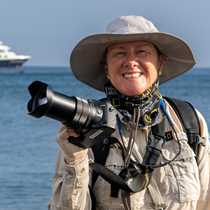Baranof Island
Takatz Bay is a Tlingit name first recorded by the United States Coastal and Geologic Survey on their map of 1899. For us it was a beautiful and still body of water, a finger of the ocean that fills a steep-sided fiord on the eastern shoreline of Baranof Island. The birders on board had a very good list going before long, though nothing of the large, four-legged hairy kind was seen on the beaches or the meadow at the head of the bay.
Later, after breakfast, we pulled up to the magnificent waterfall inside Kasnyku Bay, then followed blows of humpback whales out into Chatham Strait. They surfaced smoothly and fluked periodically, meaning a disappearance of anywhere between five and ten minutes, deep diving. Food can’t be easy just yet here in Southeast Alaska, but will improve with longer hours of daylight and nutrients exploding in quantity.
By lunchtime we had moved into Kelp Bay and just as the kayaks were headed for shore to be unloaded, two brown bears were spotted on a beach nearby. Almost simultaneously a mother and calf humpback whale appeared practically next to the ship, and the excitement level ratcheted up for us all, guests and crew alike!
Shortly afterwards the hikers to Pond Island set off (the bears had left ASAP when they got a whiff of us, despite trying to be subtle and surreptitious) into the temperate rainforest of the Tongass National Forest. In the end, just about everyone and not just the kayakers had time to idle in the channel where the humpback mother and calf spent their afternoon.
Hearing the whale blows followed by enormous flukes lifted tall, seeing bald eagles perched in spruce, marbled murrelets chirrup loudly, and the blue, blue sky overhead, I thought “we couldn’t have asked for more; what an amazing country!”
Takatz Bay is a Tlingit name first recorded by the United States Coastal and Geologic Survey on their map of 1899. For us it was a beautiful and still body of water, a finger of the ocean that fills a steep-sided fiord on the eastern shoreline of Baranof Island. The birders on board had a very good list going before long, though nothing of the large, four-legged hairy kind was seen on the beaches or the meadow at the head of the bay.
Later, after breakfast, we pulled up to the magnificent waterfall inside Kasnyku Bay, then followed blows of humpback whales out into Chatham Strait. They surfaced smoothly and fluked periodically, meaning a disappearance of anywhere between five and ten minutes, deep diving. Food can’t be easy just yet here in Southeast Alaska, but will improve with longer hours of daylight and nutrients exploding in quantity.
By lunchtime we had moved into Kelp Bay and just as the kayaks were headed for shore to be unloaded, two brown bears were spotted on a beach nearby. Almost simultaneously a mother and calf humpback whale appeared practically next to the ship, and the excitement level ratcheted up for us all, guests and crew alike!
Shortly afterwards the hikers to Pond Island set off (the bears had left ASAP when they got a whiff of us, despite trying to be subtle and surreptitious) into the temperate rainforest of the Tongass National Forest. In the end, just about everyone and not just the kayakers had time to idle in the channel where the humpback mother and calf spent their afternoon.
Hearing the whale blows followed by enormous flukes lifted tall, seeing bald eagles perched in spruce, marbled murrelets chirrup loudly, and the blue, blue sky overhead, I thought “we couldn’t have asked for more; what an amazing country!”




